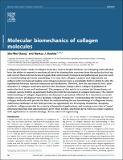| dc.contributor.author | Chang, Shu-Wei | |
| dc.contributor.author | Buehler, Markus J | |
| dc.date.accessioned | 2014-07-08T18:24:49Z | |
| dc.date.available | 2014-07-08T18:24:49Z | |
| dc.date.issued | 2014-03 | |
| dc.identifier.issn | 13697021 | |
| dc.identifier.uri | http://hdl.handle.net/1721.1/88203 | |
| dc.description.abstract | Collagenous tissues, made of collagen molecules, such as tendon and bone, are intriguing materials that have the ability to respond to mechanical forces by altering their structures from the molecular level up, and convert them into biochemical signals that control many biological and pathological processes such as wound healing and tissue remodeling. It is clear that collagen synthesis and degradation are influenced by mechanical loading, and collagenous tissues have a remarkable built-in ability to alter the equilibrium between material formation and breakdown. However, how the mechanical force alters structures of collagen molecules and how the structural changes affect collagen degradation at molecular level is not well understood. The purpose of this article is to review the biomechanics of collagen, using a bottom-up approach that begins with the mechanics of collagen molecules. The current understanding of collagen degradation mechanisms is presented, followed by a discussion of recent studies on how mechanical force mediates collagen breakdown. Understanding the biomechanics of collagen molecules will provide the basis for understanding the mechanobiology of collagenous tissues. Addressing challenges in this field provides an opportunity for developing treatments, designing synthetic collagen materials for a variety of biomedical applications, and creating a new class of ‘smart’ structural materials that autonomously grow when needed, and break down when no longer required, with applications in nanotechnology, devices and civil engineering. | en_US |
| dc.description.sponsorship | National Science Foundation (U.S.) | en_US |
| dc.description.sponsorship | United States. Office of Naval Research. Presidential Early Career Award for Scientists and Engineers | en_US |
| dc.description.sponsorship | National Institutes of Health (U.S.) (U01EB014976) | en_US |
| dc.language.iso | en_US | |
| dc.publisher | Elsevier | en_US |
| dc.relation.isversionof | http://dx.doi.org/10.1016/j.mattod.2014.01.019 | en_US |
| dc.rights | Creative Commons Attribution Non-Commercial No-Derivatives | en_US |
| dc.rights.uri | http://creativecommons.org/licenses/by-nc-nd/3.0/ | en_US |
| dc.source | Elsevier | en_US |
| dc.title | Molecular biomechanics of collagen molecules | en_US |
| dc.type | Article | en_US |
| dc.identifier.citation | Chang, Shu-Wei, and Markus J. Buehler. “Molecular Biomechanics of Collagen Molecules.” Materials Today 17, no. 2 (March 2014): 70–76. © 2014 Elsevier Ltd. | en_US |
| dc.contributor.department | Massachusetts Institute of Technology. Center for Computational Engineering | en_US |
| dc.contributor.department | Massachusetts Institute of Technology. Department of Civil and Environmental Engineering | en_US |
| dc.contributor.department | Massachusetts Institute of Technology. Department of Materials Science and Engineering | en_US |
| dc.contributor.department | Massachusetts Institute of Technology. Laboratory for Atomistic and Molecular Mechanics | en_US |
| dc.contributor.mitauthor | Chang, Shu-Wei | en_US |
| dc.contributor.mitauthor | Buehler, Markus J. | en_US |
| dc.relation.journal | Materials Today | en_US |
| dc.eprint.version | Final published version | en_US |
| dc.type.uri | http://purl.org/eprint/type/JournalArticle | en_US |
| eprint.status | http://purl.org/eprint/status/PeerReviewed | en_US |
| dspace.orderedauthors | Chang, Shu-Wei; Buehler, Markus J. | en_US |
| dc.identifier.orcid | https://orcid.org/0000-0002-4173-9659 | |
| mit.license | PUBLISHER_CC | en_US |
| mit.metadata.status | Complete | |
